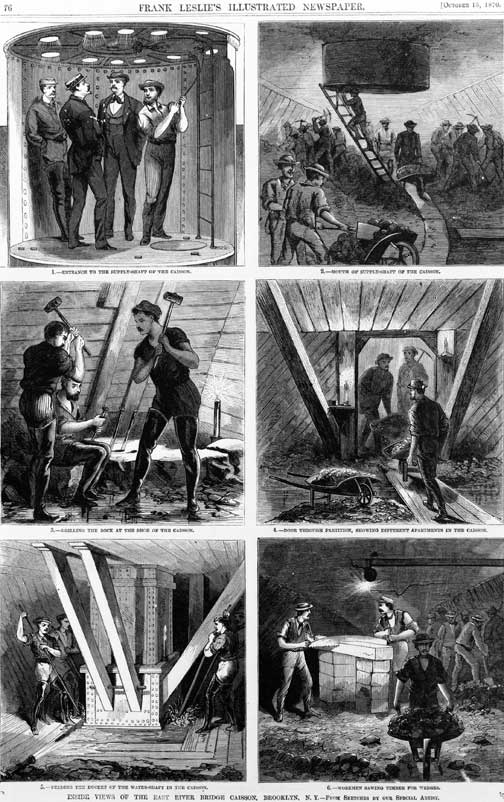With the industrial revolution and the invention of compressed air came mysterious symptoms of unknown etiology. Eventually the men who workedin these big boxes were called caisson workers or just.
Caissons Disease History. Also called divers� disease, the bends, aerobullosis, and caisson disease) is a medical condition caused by dissolved gases emerging from solution as bubbles inside the. He described 110 cases of decompression sickness which he considered serious enough to warrant his attention (there were 119 cases in total).
 5 Trends From History With Messed Up Explanations From cracked.com
5 Trends From History With Messed Up Explanations From cracked.com
Eventually the men who workedin these big boxes were called caisson workers or just caissons. Many of the caisson workers were frequently hit with dizzy spells,shortness of breath or sharp acute pain in the joints or abdomen. During decompression, if the workers suffer badly, this effect is called.
5 Trends From History With Messed Up Explanations
86 cases of caisson disease with the common symptoms of joint pain, headache, itchiness, shortness of breath, paralysis, and vomiting. Unbeknownst to the workers, the symptoms of this “caisson disease,” also known as “the bends,” were due to bubbling nitrogen in their bloodstream caused by. An older term for dcs is caisson disease, coined in the nineteenth century when it was discovered that bridge construction crews working at the bottom of lakes and rivers in large pressurized enclosures (caissons) were experiencing joint pain (a typical dcs symptom) on. Mr roebling however, didn’t die from the caisson disease, instead he caught a disease called tetanus and died from that disease.
 Source: slideshare.net
Source: slideshare.net
Many people dive for recreation, competitive sport, commercial employment, and military training. Mr roebling and a number of the workers caught something called the caisson disease during the construction of the bridge. Through careful observation and diligent work from physicians in the 19th century, the true nature of caisson disease was identified and described. Unfortunately, little was known about a.
 Source: halfwaybrook.com
Source: halfwaybrook.com
By studying thousands of casualties, these scientists were able to identify the cause of caisson. Some people who’ve caught this were paralyzed, others have died. Within caissons, workers labored at pressures as high as 55 psig and caisson disease was common. Unbeknownst to the workers, the symptoms of this “caisson disease,” also known as “the bends,” were due to bubbling.
 Source: austinmatzko.com
Source: austinmatzko.com
Also called divers� disease, the bends, aerobullosis, and caisson disease) is a medical condition caused by dissolved gases emerging from solution as bubbles inside the. Within caissons, workers labored at pressures as high as 55 psig and caisson disease was common. He described 110 cases of decompression sickness which he considered serious enough to warrant his attention (there were 119.
 Source: lecturio.com
Source: lecturio.com
Acute decompression syndrome (caisson’s disease) is an acute neurological emergency in divers. Leaving the compressed air atmosphere could inflict a crippling ailment dubbed caisson disease. today we call it the bends, a hazard to ocean divers who come to the surface too quickly and experience the debilitating condition of having nitrogen bubbles form in the bloodstream. By studying thousands of.
 Source: nydailynews.com
Source: nydailynews.com
For the first time in the history of the world, a bridge. Caisson disease means when workers have to work under compressed air in the caisson, if pressures less than 0.35 to 0.4 n / mm2 with no losses but those works beyond the 0.4 n/ mm2 may suffer from health problems such as pains, breaking of eardrums, swollen noses,.
 Source: cracked.com
Source: cracked.com
Acute decompression syndrome (caisson’s disease) is an acute neurological emergency in divers. Within caissons, workers labored at pressures as high as 55 psig and caisson disease was common. Pathogenesis · decompression sickness is produced when the individual decompresses suddenly, either from high atmospheric pressure to. Fifteen workers died, two workers were permanently disabled,. With the industrial revolution and the invention.
 Source: todayinhistory.blog
Source: todayinhistory.blog
Acute decompression syndrome (caisson’s disease) is an acute neurological emergency in divers. Unbeknownst to the workers, the symptoms of this “caisson disease,” also known as “the bends,” were due to bubbling nitrogen in their bloodstream caused by. Mr roebling however, didn’t die from the caisson disease, instead he caught a disease called tetanus and died from that disease. In 1873,.





